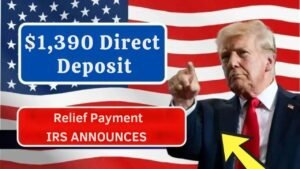With inflation, rising rent, and increasing grocery prices affecting millions of Americans, the federal government is preparing a new $1,000 stimulus payment for November 2025. Although final legislative approval is still pending, the IRS is already outlining the process to ensure fast and smooth distribution once the payment is authorized. For many families, this one-time stimulus could offer much-needed relief heading into the winter season.
Who Qualifies for the $1,000 Stimulus Payment?
The 2025 $1,000 stimulus is designed to support low- and middle-income households most affected by rising living costs. Eligibility will be based mainly on 2024 tax returns, similar to previous federal relief programs.
Basic Requirements
- Must be a U.S. citizen, lawful permanent resident, or resident alien
- Must have a valid Social Security number
- Cannot be claimed as a dependent on another taxpayer’s return
- Must meet income limits based on filing status
Income Limits for Full & Partial Payments
You may receive the full $1,000 payment if your income is within these limits:
- Single filers: Up to $75,000
- Married couples filing jointly: Up to $150,000
- Head of household: Up to $112,500
Phase-out limits apply up to:
- $99,000 for single filers
- $198,000 for married couples
- $136,500 for head of household
These limits help ensure the payment reaches those who need it most.
Direct Deposit Recipients Get Paid Faster
Individuals with updated direct deposit information will receive the stimulus earlier than those depending on paper checks or prepaid debit cards.
Payment Schedule: When Will You Get the $1,000?
The IRS is expected to release the payment in three phases throughout November and early December.
Phase 1: November 8–12
- Direct deposits for individuals with accurate and up-to-date banking information
Phase 2: November 15–22
- Direct deposits for taxpayers who recently updated bank details
Phase 3: Late November to Mid-December
- Paper checks
- Prepaid debit cards
- Payments for those without direct deposit setup
This phased approach ensures smooth payment delivery and minimizes IRS processing delays.
How to Receive Your Payment Faster
To avoid delays and ensure timely delivery, the IRS recommends the following steps:
1. File Your 2024 Tax Return
Payments are based on tax return data. Completing your 2024 return early ensures smooth processing.
2. Update Banking & Personal Details
Make sure:
- your bank account number
- mailing address
- phone number
are current with the IRS.
3. Use IRS Online Tools
When payments begin, tools like Get My Payment will help track your deposit status.
4. Non-Filers Should Use the Simplified Portal
A simplified filing system will be available for:
- low-income individuals
- seniors
- others who do not usually file taxes
This ensures they are not left out of the stimulus.
Key Things to Know About the $1,000 Stimulus
- The payment is non-taxable.
- It does not affect Social Security, SSI, SSDI, or VA benefits.
- Mixed-status households may receive partial or adjusted payments.
- Dependents do not get separate checks but are included in the household payment.
Staying informed and prepared can help prevent delays once payments begin.
FAQs About the $1,000 Stimulus Payment
1. Is the $1,000 stimulus payment officially approved?
Not yet. Final approval is pending, but the government is preparing for distribution.
2. How will I receive the payment?
Mostly through direct deposit. If you don’t have it, you will receive a paper check or debit card.
3. Do non-filers need to submit anything?
Yes. A simplified IRS portal will allow non-filers to claim their payment easily.
4. Will the payment affect SSI, SSDI, or Social Security benefits?
No. The stimulus is non-taxable and does not reduce federal benefits.
5. How do I check my payment status?
Once payments start, the IRS will activate the Get My Payment tracker.
Conclusion
The upcoming $1,000 stimulus payment for November 2025 could help millions of Americans manage essential expenses during a challenging economic period. While final approval is still pending, preparing now—by updating tax information, checking direct deposit details, and monitoring IRS updates—ensures that you receive your payment quickly once the program launches.





